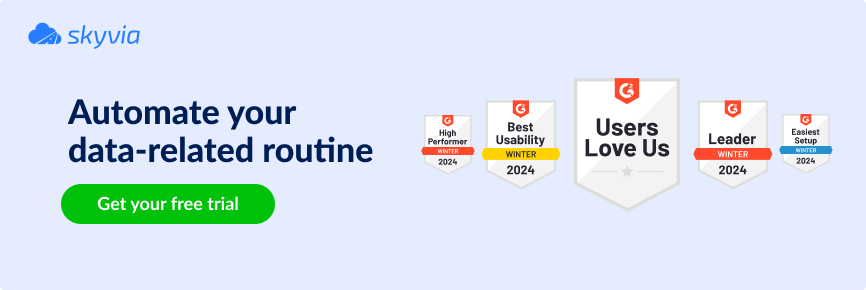If you’ve ever worked with databases or heard about database design, you have come across the term “data modeling tools” – software applications that allow users to create a visual representation of a database’s structure. They help map out how different pieces of data relate to each other and define the database’s structure.
Why are they Important in Database Design
- Blueprint for Databases. Like architects use blueprints to design buildings, data engineers use these tools to provide a clear plan of what the database will look like and how it will function.
- Visual Representation. Visualizing data lets users see relationships and dependencies between different entities to design effective databases easily.
- Improved Data Management. A solid data model gives users a clear structure showing how data is stored, accessed, and manipulated.
- Facilitates Communication. As it provides a common language and visualization that everyone can understand, it makes communication for technical and non-technical users easier. Such an approach is crucial during the design phase: enhance collaboration, and allow to keep clear documentation.
In this article, we’ll review the best data modeling tools for 2025, their key features, and the benefits for businesses to choose the right tool for your organization.
Table of contents
- Key Features of Data Modeling Tools
- Top Data Modeling Tools for 2024
- Comparison of Data Modeling Tools
- Benefits of Using Data Modeling Tools
- How to Choose the Right Data Modeling Tool
- Work Together with Data Modeling Tools
- Conclusion
Key Features of Data Modeling Tools
Good data modeling tools streamline the process, improve collaboration, and ensure that data structures are well-documented and ready for implementation. Let’s review the key features of such tools.
1. Diagramming Capabilities
It’s the heart of data modeling tools, allowing the creation of visual representations of database structure, usually in the form of Entity-Relationship Diagrams (ERDs) that help map out tables, relationships, and data flows.
2. Reverse Engineering
This feature is handy for understanding legacy databases or systems users didn’t initially design. The tool analyzes the database and generates a model to visualize and document the current structure, making it easier to plan changes or integrations.
3. Collaboration Support
Collaboration allows multiple users to work simultaneously on the same data model, often with real-time updates and change tracking.
Moreover, data modeling tools often include automatic documentation features, generating clear, detailed descriptions of the database structure as it’s being designed. All team members can easily share and reference this documentation, providing a reliable source of truth that facilitates ongoing communication and project continuity.
4. Integration with Databases
Integration capabilities allow the tool to connect directly to various database management systems (DBMS), such as MySQL, PostgreSQL, Oracle, etc. So, users can easily push their model to the database or pull existing structures into the tool to save time and reduce errors when moving from design to implementation.
5. Forward Engineering
It takes the data model and generates the SQL code to create the database structure in the chosen DBMS. This feature bridges the gap between design and implementation, allowing the model to be deployed quickly without manually writing all the SQL scripts, ensuring that the database is built exactly as designed.
6. Data Type and Constraint Specification
This feature directly defines data types, primary keys, foreign keys, and other constraints in the model. Specifying data types and constraints ensures data integrity and consistency, which are crucial for maintaining a reliable database.
7. Version Control
Version control features provide tracking changes to data models over time, often integrating with existing version control systems like Git. It’s essential for managing changes and collaborating on complex projects. It keeps track of different iterations of the model and reverts to previous versions if needed.
8. Reporting and Documentation
Many tools offer features to automatically generate documentation and reports based on data models to ensure everyone understands the data model and its purpose. It’s handy for onboarding new team members or sharing models with users.
Top Data Modeling Tools for 2024
If you’re working in the database design area or searching for a tool to improve data management processes, here’s a list of the top data modeling tools for 2024. Each of them provides unique features catering to different needs and preferences.
ER/Studio
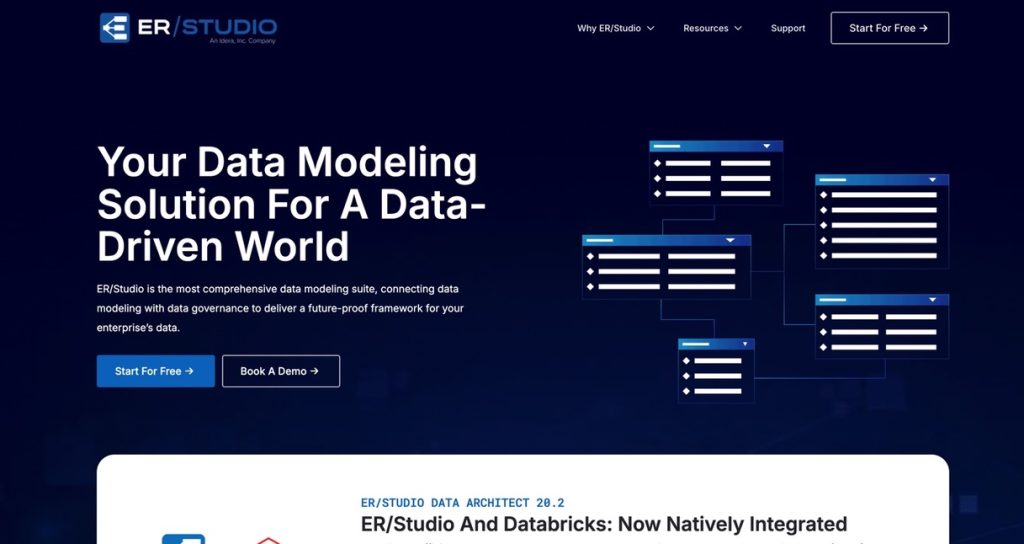
ER/Studio is a powerful data modeling tool designed to help businesses and organizations create, manage, and optimize complex database architectures. Developed by IDERA, it’s particularly popular in enterprise environments where managing large-scale data structures is essential.
It’s widely used by large enterprises that need to manage extensive, complex databases and organizations that require detailed data integrity.
Key Features
- Data Modeling. Supports logical, physical, and conceptual data modeling, allowing users to design complex database structures.
- Collaboration. Offers team collaboration features, enabling multiple users to work on models simultaneously.
- Data Lineage. Tracks data flow across systems to ensure data integrity and transparency.
- Integration. Seamlessly integrates with various DBMS and business intelligence tools.
Benefits
- The tool enhances productivity with automation features and model-driven development.
- It provides robust reporting and documentation abilities to streamline communication across teams.
- The solution facilitates compliance with data governance standards.
Use Cases
- It’s perfect for businesses looking to manage extensive data architectures.
- The solution is helpful for companies requiring detailed data lineage and impact analysis.
Oracle SQL Developer Data Modeler
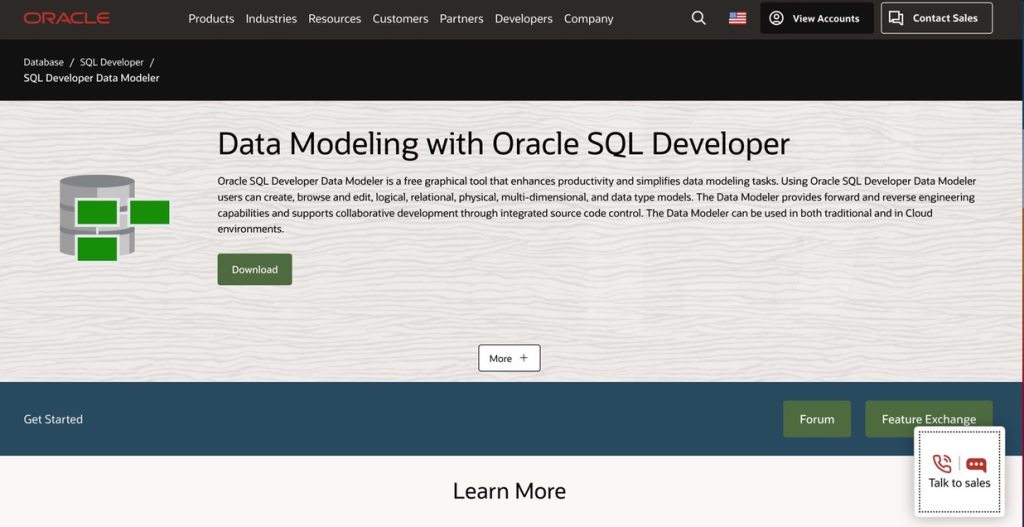
Oracle SQL Developer Data Modeler is a free, comprehensive data modeling and design tool that supports Oracle databases and other DBMS and provides a full suite of design tools for creating and modifying database models. It allows users to create models from existing databases and generates DDL scripts to implement the design on a database. The tool also offers detailed diagrams and visualizations to aid in understanding complex structures.
Key Features
- Support of multi-level designs, including logical and relational models.
- The ability to integrate with Oracle SQL Developer for seamless database management.
- The tool offers data type and constraint management for precise data definition.
Benefits
- The tool streamlines database design and implementation processes.
- It enhances collaboration with version control and model comparison features.
- The solution simplifies complex data structures with intuitive visualizations.
Use Cases
- This platform is best suited for organizations using Oracle databases.
- It’s useful for database administrators and developers who are focusing on Oracle database design and management.
DbSchema
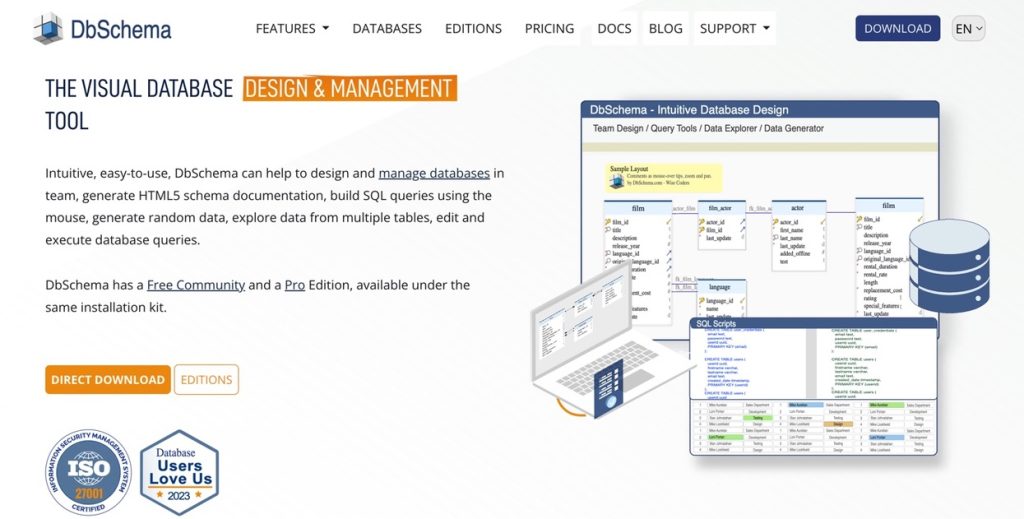
DbSchema is a robust data modeling tool with a user-friendly interface for designing and managing database schemas across various DBMS. It supports a wide range of databases, including MySQL, PostgreSQL, MongoDB, and more. So, it’s an excellent choice for multi-database projects and effortless collaboration among team members.
Key Features
- It allows users to create and edit database schemas visually with drag-and-drop functionality.
- The solution supports schema synchronization and versioning to ensure consistency across environments.
- The tool works with a wide range of databases, including MySQL, PostgreSQL, MongoDB, and more.
Benefits
- The solution simplifies the design process with intuitive visual tools and interactive layouts.
- It enables easy collaboration and sharing with built-in documentation features.
- The system supports offline schema design, allowing changes to be deployed later.
Use Cases
- DbSchema is perfect for small to medium-sized businesses seeking a cost-effective modeling solution.
- It’s suitable for teams needing to collaborate on multi-database projects.
MySQL Workbench
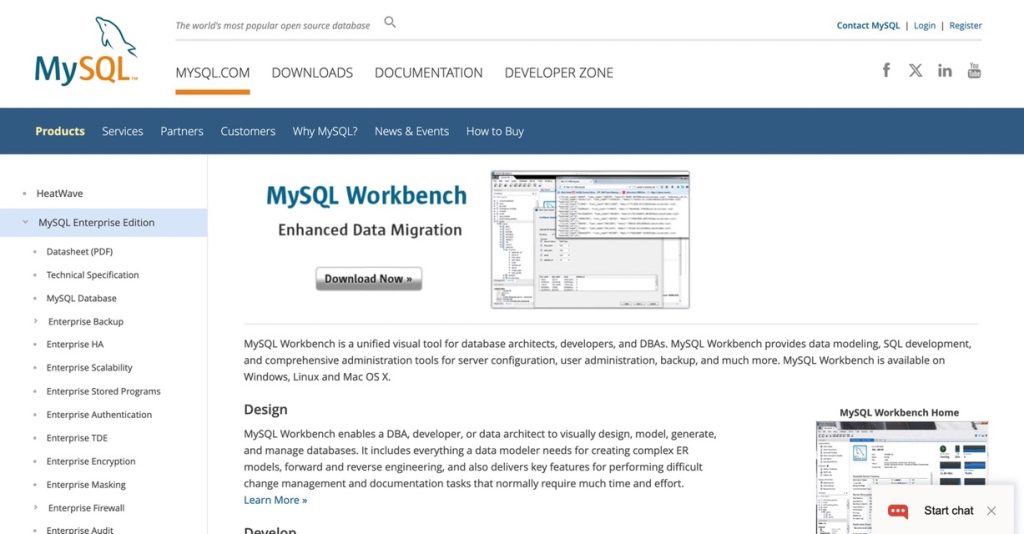
MySQL Workbench is a comprehensive and free visual tool designed for database architects, developers, and DBAs. It provides a full-featured modeling environment to create and manage complex data models, includes SQL, and offers a range of functionalities, including data modeling, SQL development, and database administration.
Key Features
- The tool supports forward and reverse engineering of MySQL databases.
- It involves visual performance dashboards and reporting tools.
- The solution offers utilities to migrate databases from Microsoft SQL Server, Microsoft Access, Sybase ASE, and more to MySQL.
Benefits
- An ability to facilitate seamless integration with MySQL databases for streamlined operations.
- Users can enhance productivity with automated design and management features.
- MySQL Workbench provides a comprehensive set of tools for all stages of database development.
Use Cases
- It’s ideal for MySQL database developers and administrators.
- The tool is helpful for teams looking to manage MySQL databases effectively.
Comparison of Data Modeling Tools
Choosing the right data modeling tool depends on the company’s specific needs, the complexity of projects, and the environment in which users work. Here’s the comparison table based on the data modeling tools’ features, pricing, ease of use, and suitability for different projects and organizations.
| Feature | ER/Studio | Oracle SQL Developer Data Modeler | DbSchema | MySQL Workbench |
|---|---|---|---|---|
| Key Features | – Comprehensive data modeling (logical, physical, conceptual) – Team collaboration. – Data lineage and impact analysis – Integration with various DBMS and BI tools | – Supports multi-level designs (logical, relational) – Reverse and forward engineering – Data type and constraint management – Integration with Oracle SQL Developer | – Visual design tools – Schema synchronization. – Cross-platform support (MySQL, PostgreSQL, MongoDB, etc.). – Interactive layouts | – Unified visual tool – Forward and reverse engineering. – SQL development – Server configuration and user administration – Visual performance dashboards |
| Pricing | Starts at approximately $1,500 per user per year | Free | $127 (perpetual license) | Free |
| Ease of Use | Advanced features require a learning curve | User-friendly for Oracle environments but may need some learning | User-friendly interface, easy to use | User-friendly, especially for MySQL users |
| Suitability for Projects | – Large enterprises – Complex database architectures – Teams requiring detailed data lineage and impact analysis | – Projects using Oracle databases – Database administrators and developers focusing on Oracle environments | – Teams working on multi-database projects – Users needing visual design and schema synchronization | – MySQL database developers and administrators – Small to medium-sized projects – Users looking for comprehensive MySQL management tools |
| Suitability for Organizations | – Large organizations with extensive data management needs – Enterprises requiring robust collaboration and governance features | – Oracle-centric organizations – Companies with extensive Oracle database infrastructure | – Small to medium-sized companies – Organizations needing multi-database support and visual design tools | – Organizations heavily using MySQL. – Businesses looking for a free and comprehensive tool for MySQL management |
Benefits of Using Data Modeling Tools
Data modeling tools can transform how users design, manage, and interact with databases. They can improve data quality, facilitate collaboration, enhance efficiency, and ensure compliance. Let’s examine them more closely to see how they may benefit your business.
Improved Data Quality
- Data modeling tools help ensure that data structures are designed accurately from the outset. By defining clear data types, constraints, and relationships, these tools help maintain data consistency and integrity.
- Automated validation features in data modeling tools can catch errors early in the design phase, reducing the risk of data inconsistencies and inaccuracies when the database is implemented.
Better Collaboration Among Team Members
- Many data modeling tools support collaboration features that allow multiple team members to work on the same model simultaneously. It includes real-time updates, version control, and change tracking.
- Visual models and diagrams make it easier for technical and non-technical users to understand the database structure to foster better communication.
More Efficient Database Design Processes
- Data modeling tools automate many aspects of database design, including generating SQL scripts, reverse engineering existing databases, and synchronizing schemas. It speeds up the design process and reduces manual work.
- Tools that offer visual design capabilities allow users to create and modify database schemas easily. Drag-and-drop interfaces and visual representations simplify design of complex structures.
Enhanced Data Integration
- Data modeling tools help create a unified view of data across different systems by defining how data is structured and related. Such an approach is beneficial in environments with multiple databases or data sources.
- These tools facilitate smoother integration with other systems and applications by providing clear models and schemas, ensuring that data flows seamlessly across the organization.
Clearer Documentation and Compliance
- Many data modeling tools automatically generate documentation based on the data models, including tables, columns, relationships, and constraint descriptions.
- Clear documentation and defined data structures help ensure databases comply with industry regulations and standards, such as GDPR or HIPAA.
How to Choose the Right Data Modeling Tool
Selecting the perfect data modeling tool involves evaluating project complexity, team size, and specific feature needs while balancing these against the company’s budget. Here’s a guide to help businesses make the best choice.
Evaluate Your Specific Requirements
- A basic tool might suffice if you’re working on smaller projects with straightforward data structures. Look for tools that offer easy-to-use interfaces and essential features without overwhelming you with options.
- You’ll need a more robust tool for more complex projects involving large-scale databases, intricate relationships, or multiple data sources. Look for features like advanced diagramming, data lineage, and impact analysis.
Consider the Size of Your Team
- Simplicity is essential if you’re in a small team. Tools with intuitive interfaces and minimal learning curves are ideal.
- For larger teams, collaboration features become crucial. Look for tools that support real-time collaboration, version control, and role-based access.
Assess the Features of Different Tools
- Smooth integration with existing DBMS (e.g., MySQL, PostgreSQL, Oracle), cloud platforms, and other tools organizations already use reduces manual work and ensures consistency across data environments. So, ensure that all team members can collaborate seamlessly and keep track of changes without conflicts.
Think about Ease of Use
- Look for tools with drag-and-drop functionalities, comprehensive help resources, and community support. So, a tool that’s easy to use will save time and reduce the learning curve for teams, leading to quicker implementation and fewer errors.
Balance Features with Budget
- Open-source tools can be a great option if you’re on a tight budget. They often provide much functionality for free or at a lower cost. However, they might require more technical expertise to set up and use.
- MySQL Workbench, DbSchema has a paid version but also offers a free option.
- Commercial tools generally offer more advanced features, better support, and easier integration. They can be more user-friendly but come at a higher cost.
Evaluate Cost vs. Benefits
- Look at the total cost of ownership, including licensing fees, training costs, and any additional costs for support or upgrades.
- Weigh these costs against the benefits of the tool’s features to see if it saves you time, improves data quality, or enables better collaboration and productivity.
Trial and Feedback
- Take advantage of free trials offered by many commercial tools. It allows businesses to test the tool in their environment and see how it fits their workflow.
- Get input from your team members who will be using the tool. Their feedback is invaluable in making sure the tool meets everyone’s needs.
Work Together with Data Modeling Tools
Modern businesses usually use the orchestra of various services that are excellent in themselves. Still, companies can only evolve once their heads can view the whole market picture, including top trends and clients’ behavior. That’s why they need all the information in one place (DWH, data lake, etc.) and data integration tools to provide this kind of connectivity.
Data modeling tools are essential for designing and visualizing database structures, but they become even more powerful when integrated with tools like Skyvia. This universal cloud-based data integration platform works hand-in-hand with popular data modeling tools to smoothly manage data.
Let’s explore how such solutions really play the changing game in the world of data management.
Building and Maintaining Data Structures
- Data modeling tools help users design and visualize a database’s structure. They’re like the blueprint for storing, organizing, and related data within a database. Users define all the foundational elements of data infrastructure, like tables, columns, relationships, and constraints.
- Once users model the data structure, the next step is to populate it with actual data using data integration tools like Skyvia. After designing the blueprint with a data modeling tool, we may use Skyvia to integrate data from 190+ sources into a new or existing database, ensuring that the data fits the designed structure.
Data Import and Synchronization
- Tools like Skyvia allow moving data between different systems, synchronizing data across platforms, and ensuring that data is consistent and up-to-date across all users’ databases and applications.
- When data structure changes (e.g., users add new tables or fields based on their updated data model), Skyvia helps keep the data in sync with these changes. It can import data into the newly designed structures, ensuring that data is well-organized and accurate according to the latest model.
Data Transformation and Consistency
- Data modeling tools ensure that data is stored in a consistent, logical format. They help users define rules for how data should be structured and how different data elements should relate to one another.
- Data integration tools like Skyvia move data and transform it as needed during the integration process. Suppose the data modeling tool defines a specific format for dates. In that case, Skyvia can ensure that all incoming data is transformed to match this format before loading it into the database.
Conclusion
Selecting the right data modeling tool isn’t just about picking the one with the most features; it’s about finding the one that fits your specific needs. Whether working on a simple project or managing a complex database architecture for a large enterprise, such a tool should make your life easier and offer the needed features, like collaboration, integration, and automation, while fitting within your budget.
